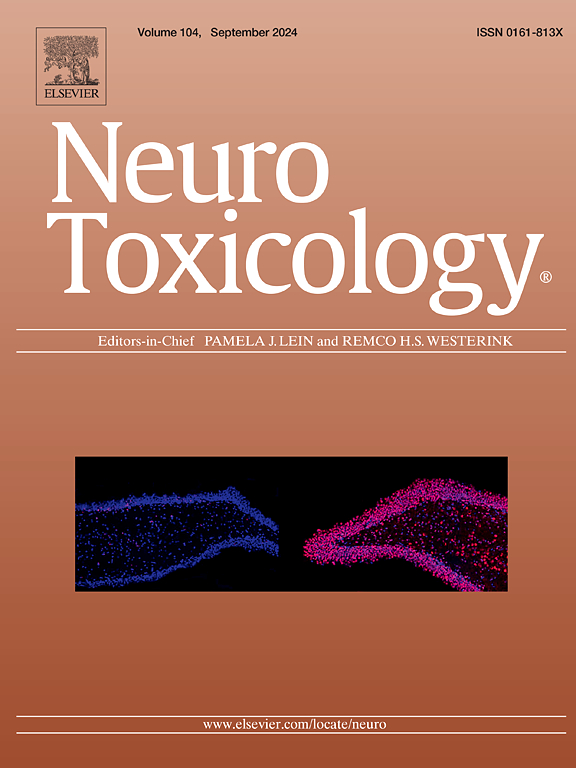尿素改善鱼tenone帕金森病模型α-突触核蛋白聚集和DNMT1表达
IF 3.9
3区 医学
Q2 NEUROSCIENCES
引用次数: 0
摘要
α-突触核蛋白聚集是帕金森病(PD)、路易体痴呆(DLB)和多系统萎缩(MSA)的重要标志。我们使用硅和体外方法研究了尿石素(UA、UB、UC、UD、UE、UM5和UM6)对α-突触核蛋白聚集的多靶向作用。为了进行计算机分析,我们选择了几个潜在的靶点,如1XQ8 (α-突触核蛋白单体)、1H1D(儿茶酚-o-甲基转移酶)、2BK3(单胺氧化酶- b)、3IAM (NADH脱氢酶)、4I5I (Sirtuin-1)和5WVO [DNA甲基转移酶-1],它们在α-突触核蛋白聚集、左旋多巴降解和线粒体功能障碍中起关键作用。在蛋白-蛋白对接分析中,发现5HF9(乙酰胆碱酯酶,AChE)与1XQ8二聚体相互作用,形成一个更稳定的复合物,有两个额外的氢键和一个盐桥,这表明AChE在α-突触核蛋白聚集中起成核作用。在配体对接和分子动力学研究中,与特异性抑制剂1XQ8- zpd2和特异性激活剂4I5I-白藜芦醇相比,尿石素- a (UA)与1XQ8、4I5I和5WVO形成了更稳定的复合物。而其他尿石素(UE、UM5、UC和UD)与5HF9、2BK3、1H1D和3IAM的配合物分别比特异性抑制剂5HF9-芥子碱、2BK3-selegiline、1H1D- bia和特异性激活剂3IAM-白藜芦醇的配合物更稳定。预测UA血脑屏障通透性(QPlogBB:−0.97)高于左旋多巴(QPlogBB:−1.44),低于鱼藤酮(QPlogBB: 0.08)。DNMT1抑制剂(5-Aza-dC)和鱼tenone显著降低了Neuro 2 A细胞中DNMT1和α-synuclein的表达,而31.25 µM浓度的UA处理显著逆转了DNMT1和α-synuclein的表达。这些发现表明尿石素,特别是UA、UC、UD、UE和UM5对α-突触核蛋白聚集具有潜在的抑制作用。本文章由计算机程序翻译,如有差异,请以英文原文为准。
Urolithin improves α-synuclein aggregation and DNMT1 expression in rotenone model of Parkinson’s disease
α-synuclein aggregation is a key hallmark of Parkinson’s disease (PD), dementia with Lewy bodies (DLB), and multiple system atrophy (MSA). We examined the multi-targeting effects of urolithin (UA, UB, UC, UD, UE, UM5, and UM6) against α-synuclein aggregation using an in-silico and in-vitro approach. For in-silico analysis, several potential targets were selected like 1XQ8 (α-synuclein monomer), 1H1D (catechol-o-methyltransferase), 2BK3 (monoamine oxidase-B), 3IAM (NADH dehydrogenase), 4I5I (Sirtuin-1), and 5WVO [DNA methyltransferase-1], which play key role in α-synuclein aggregation, levodopa degradation, and mitochondrial dysfunction. In protein-protein docking analysis, 5HF9 (acetylcholinesterase, AChE) was found to interact with 1XQ8 dimer, forming a more stable complex with two additional H-bonds and one salt bridge, which indicates AChE's role as a nucleator in α-synuclein aggregation. In ligand docking and molecular dynamic studies, urolithin-A (UA) formed a more stable complex with 1XQ8, 4I5I, and 5WVO compared to specific inhibitor 1XQ8-ZPD2 and specific activator 4I5I-resveratrol. While other urolithins (UE, UM5, UC, and UD) displayed a more stable complex with 5HF9, 2BK3, 1H1D, and 3IAM compared to specific inhibitor 5HF9-physostigmine, 2BK3-selegiline, 1H1D-BIA, and specific activator 3IAM-resveratrol complexes, respectively. The blood-brain barrier permeability of UA (QPlogBB: −0.97) was predicted to be more than levodopa (QPlogBB: −1.44) and less than rotenone (QPlogBB: 0.08). DNMT1 inhibitor (5-Aza-dC) and rotenone robustly decreased the DNMT1 and α-synuclein expression in Neuro 2 A cells which was significantly reversed by UA treatment at 31.25 µM concentration. These findings indicate the potential of urolithins, specifically UA, UC, UD, UE, and UM5 against α-synuclein aggregation.
求助全文
通过发布文献求助,成功后即可免费获取论文全文。
去求助
来源期刊

Neurotoxicology
医学-毒理学
CiteScore
6.80
自引率
5.90%
发文量
161
审稿时长
70 days
期刊介绍:
NeuroToxicology specializes in publishing the best peer-reviewed original research papers dealing with the effects of toxic substances on the nervous system of humans and experimental animals of all ages. The Journal emphasizes papers dealing with the neurotoxic effects of environmentally significant chemical hazards, manufactured drugs and naturally occurring compounds.
 求助内容:
求助内容: 应助结果提醒方式:
应助结果提醒方式:


